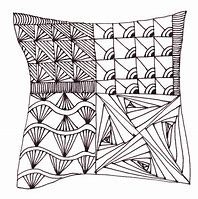In a recent input in Discovering Maths, we had a chance to create some mathematical art and my favourite of these was a curve of pursuit.
(MathsMasterOrg (2011))
This is created by choosing a regular shape, making a mark an equal distance from each corner and joining these dots to create a slightly smaller shape. Then repeat…and repeat…and repeat…
The finished product is almost an optical illusion – the straight lines appear curved and it is hard to believe it is created purely by drawing straight lines. I think this is a useful activity to try with a primary school class because it provides an opportunity to develop a specialist knowledge of fundamental mathematics. A curve of pursuit can reinforce the basic idea (Ma, 2010) of the properties of shape by challenging the perception of what a square normally looks like as well as concepts like rotation.
The intersecting lines and the amount of patience required to draw this reminded me of an activity I did with the class I taught on my recent placement.

Zentangle is described as a relaxing way to create a piece of art by using simple lines within a shape to create ”tangles” and each ”tangle” is filled with a repeated pattern. I had chosen to try this activity during a particularly hectic few days for the class for a bit of mindfulness and I also recognised an opportunity in the intricate patterns for the children to work on their fine-motor skills.
For more information : https://zentangle.com/pages/what-is-the-zentangle-method
There are no rules in Zentangle – something I thought the children would be pleased to hear but they were very hesitant to start without being told exactly what to do. We looked at some examples together and soon after, they all set off ready to get creative. Haylock and Thangata (2007) made sense of this reaction for me in discussing how when mathematical concepts are involved, shape in this instance, children are normally concerned with giving the ”right” answer – thinking divergently. However, without realising, I was asking them to think convergently in this activity which meant they needed to allow for more flexibility and openness to see what would happen, for want of a better phrase. We all really enjoyed it in the end as an art lesson.
Throughout this module, I have become more aware of opportunities to exploit the fundamental concepts of mathematics and I wondered if I could combine these two activities to give more mathematical purpose to Zentangle.

Admittedly, I would increase the measurements next time to give myself more space and I probably spent far too long doing this
BUT
I do think this hybrid of Zentangle/curve of pursuit is a good way of exploring the properties of shape whilst also considering Curriculum for Excellence’s principles for curriculum design (Scottish Government, 2018). It incorporates personalisation and choice by encouraging the children to choose which regular shape they would like to use to create a piece of art as well as the patterns they fill it with and coherence as it could be used as one of a series of lessons looking at mathematical patterns in artwork.
References
Haylock, D. and Thangata, F. (2007) Key Concepts in Teaching Primary Mathematics. Los Angeles: SAGE Publications Ltd (SAGE Key Concepts). Available at: http://libproxy.dundee.ac.uk/login?url=http://search.ebscohost.com/login.aspx?direct=true&db=nlebk&AN=268633&authtype=shib&site=ehost-live&scope=site [Accessed 26/11/18]
Ma, L., (2010) Knowing and teaching elementary mathematics (Anniversary Ed.) New York: Routledge.
Scottish Government (2018) What is Curriculum for Excellence? Available at https://education.gov.scot/scottish-education-system/policy-for-scottish-education/policy-drivers/cfe-(building-from-the-statement-appendix-incl-btc1-5)/What%20is%20Curriculum%20for%20Excellence [Accessed 27/11/18]


